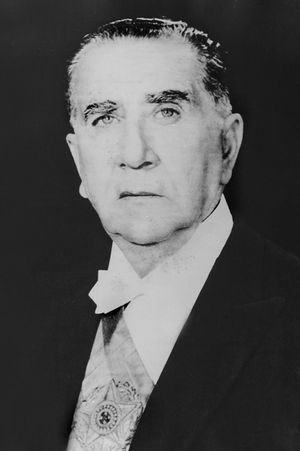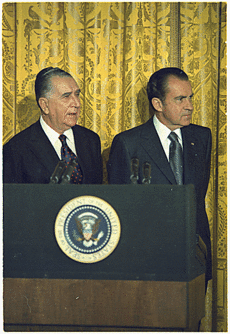إميليو ميديسي
إميليو گاراستازو مديسي | |
|---|---|
Emílio Garrastazu Médici | |
 الپورتريه الرسمي، ح. 1973 | |
| رئيس البرازيل رقم 28 | |
| في المنصب 30 أكتوبر 1969 – 15 مارس 1974 | |
| نائب الرئيس | أوگوستو رادميكر |
| سبقه | المجلس العسكري |
| خلـَفه | إرنستو گايزل |
| Head of the National Intelligence Service | |
| في المنصب 17 مارس 1967 – 28 مارس 1969 | |
| الرئيس | Artur da Costa e Silva |
| سبقه | Golbery do Couto e Silva |
| خلـَفه | Carlos Alberto da Fontoura |
| تفاصيل شخصية | |
| وُلِد | ديسمبر 4, 1905 Bagé, ريو گراندي دو سول |
| توفي | أكتوبر 9, 1985 (aged 79) ريو ده جانيرو، ريو ده جانيرو |
| المثوى | São João Batista Cemetery, Rio de Janeiro, Brazil |
| القومية | برازيلي |
| الحزب | National Renewal Alliance Party – ARENA |
| الزوج | Scylla Nogueira |
| الأنجال | 2 |
| المدرسة الأم | Military School of Realengo |
| المهنة | Military |
| التوقيع | |
| الخدمة العسكرية | |
| الولاء | |
| الفرع/الخدمة | |
| سنوات الخدمة | 1927–1969 |
| الرتبة | Army General |
| قاد |
|
| المعارك/الحروب | |
الجنرال إميليو گراستازو مديسي (Emílio Garrastazu Médici ؛ النطق في البرتغالية: [eˈmiʎu ɡɐʁastaˈzu ˈmɛd(ʒi)si]؛ و. 4 ديسمبر 1905 — ت. 9 اكتوبر 1985) هو رئيس البرازيل 28 في الفترة 1969–1974. جاء للحكم بعد مجلس حكم عسكري حكم البرازيل لفترة قصيرة بعد تدهور حالة الرئيس البرازيلي الأسبق المارشال أرتور دا كوستا إ سيلڤا.
خلفه في منصب الرئاسة الجنرال إرنستو گايزل.
. . . . . . . . . . . . . . . . . . . . . . . . . . . . . . . . . . . . . . . . . . . . . . . . . . . . . . . . . . . . . . . . . . . . . . . . . . . . . . . . . . . . . . . . . . . . . . . . . . . . . . . . . . . . . . . . . . . . . . . . . . . . . . . . . . . . . . . . . . . . . . . . . . . . . . . . . . . . . . . . . . . . . . . .
النشأة
Médici was born in Bagé, Rio Grande do Sul state. From his father's side, he was the grandson of Italian immigrants who went to Uruguay and then moved to Brazil. On his mother's side he descended from Basques. In the 1920s he entered military school at Porto Alegre and then the Army where he was steadily promoted, becoming general in 1961.
Throughout the 1950s he served as a commander of reserve forces before being appointed chief of staff to Artur da Costa e Silva from 1957 to 1960. After the military coup Médici became Brazil's military attache to the USA from 1964–1966. In 1967 Médici was appointed chief of the National Intelligence Service of Brazil.
الرئاسة
In 1969 he became commander of the Third Army and was chosen to become President of Brazil by the Brazilian Military Junta of 1969, succeeding Costa e Silva, who had suffered a stroke. As the President was elected by National Congress, it had to be re-convened for this purpose after being dismissed by Costa e Silva. Médici was the only candidate, though since the legislature was dominated by the pro-military National Renewal Alliance Party (ARENA), his election would have been a foregone conclusion in any case. The legislature elected him by a margin of 313–0, with 56 abstentions. Médici took the oath on 30 October 1969 and served until the end of his term on 15 March 1974.[بحاجة لمصدر]
السياسة المحلية
Médici ruled under a 1967 Constitution which had been amended a few months earlier to be even more authoritarian than its predecessor. This constitution, along with the Institutional Act Number Five (AI-5, which gave the government sweeping powers to censor the press and restrict civil rights), formed the legal basis for some of the most severe human rights abuses of the military's two-decade rule. He made liberal use of torture and strict press censorship. The importation of the men's magazines Playboy, Penthouse and Lui, as well as the West German news magazine Der Spiegel, was banned because they offended "morality and proper behavior".[1] His regime also spied on political opponents, many of whom were tortured and disappeared. He and his predecessor, Costa e Silva, represented the most rigidly authoritarian faction of the military, an element that was willing to stay in power for as long as it deemed necessary to increase Brazil's power.[2] Médici created Indigenous territories.[3][4]
السياسة الاقتصادية
This harsh repression came amid a period of explosive economic growth. Médici's term was met with the largest economic growth of any Brazilian President. The Brazilian Miracle unfolded, authored jointly by his liberal ministers ahead of the Ministério do Planejamento and Ministério da Fazenda (planning and finances) Roberto Campos and Delfim Netto, and the country won the 1970 Football World Cup. In 1971 Médici presented the First National Development Plan aimed at increasing the rate of economic growth especially in the remote Northeast and Amazon basin.[بحاجة لمصدر]
During the Brazilian Miracle, the economy grew rapidly at a rate of 10% per year and inflation was kept relatively low in comparison to the stratospheric levels during the governments before the implementation of the military regime. Large construction projects were undertaken, including the Trans-Amazonian Highway, the Itaipu Dam and Rio–Niterói bridge. On the other side, the economic growth benefited mainly the richer classes — by the end of 1970, the official minimum wage went down to US$40/month, and the more than one-third of the Brazilian workforce whose wages were tied to it lost about 50% of their purchasing power in relation to 1960 levels[5] at the end of Juscelino Kubitschek's administration.
انتاج الطاقة
In November 1970 federal, state, and municipal elections were held. Most of the seats were won by ARENA candidates. In 1974, he was succeeded by his handpicked choice, Ernesto Geisel, despite attempts by some hardliners to derail his candidacy.[2]
سنوات الزعامة وتهم التعذيب
During his rule, the guerrilla movement led by Carlos Marighela, leader of Ação Libertadora Nacional, and Carlos Lamarca was mostly destroyed and Marighela and Lamarca killed.[6] Revolutionary Movement 8th October was suppressed and Araguaia Guerrilla War won.
In the 1980s, the Catholic vicariate of São Paulo and Protestant ministers obtained thousands of classified documents that detailed the use of torture during Médici's term. These revelations shocked average Brazilians who had been unaware of the extensive use of torture.[7]
العلاقات الخارجية
In 1971, President Richard Nixon and Médici discussed coordinating their efforts to overthrow Cuba's Fidel Castro and Chile's Salvador Allende.[8] National security advisor Henry Kissinger's account of the 9 December 1971, White House visit by Médici was written "for the president's file" and classified Top Secret. It was declassified on 4 September 2008, and made public in July as part of a State Department publication on U.S. foreign policy.[8]

Kissinger's memo shows that it was Nixon who raised the subject of Allende during the meeting, asking for Médici's views on Chile: "Médici said Allende would be overthrown". [Nixon] then asked whether Médici thought that the Chilean armed forces were capable of overthrowing Allende. Médici replied that he felt that they were, and [he] made clear that Brazil was "working towards this end."[8] The memo notes that Nixon and Médici also discussed whether Cuba should have readmission to the Organization of American States. For his part, Médici noted that Peru was trying to persuade the OAS to consider readmitting Cuba and asked Nixon how they should cooperate to oppose the move. Nixon said he would study the issue and reply to Médici "privately". The OAS voted to lift sanctions on Cuba in 1974.[8]
بعد الرئاسة والوفاة
Médici was succeeded by General Ernesto Geisel on March 15, 1974. Upon leaving the presidency, Médici retired from public life, aside from declaring himself against the political amnesty enacted in August 1979 during the administration of João Figueiredo.
Médici would die of kidney failure on October 9, 1985 at the age of 79 after suffering a stroke. His body was buried in the São João Batista Cemetery in Rio de Janeiro.
التكريم
التكريم الأجنبي
 Grand Collar of the Military Order of Saint James of the Sword (24 April 1972)[9]
Grand Collar of the Military Order of Saint James of the Sword (24 April 1972)[9] Grand Collar of the Order of the Tower and Sword (9 May 1973)[9]
Grand Collar of the Order of the Tower and Sword (9 May 1973)[9]
. . . . . . . . . . . . . . . . . . . . . . . . . . . . . . . . . . . . . . . . . . . . . . . . . . . . . . . . . . . . . . . . . . . . . . . . . . . . . . . . . . . . . . . . . . . . . . . . . . . . . . . . . . . . . . . . . . . . . . . . . . . . . . . . . . . . . . . . . . . . . . . . . . . . . . . . . . . . . . . . . . . . . . . .
انظر أيضاً
المصادر
- ^ "Brazil: No Nudes Is...", Time, 30 April 1973.
- ^ أ ب Brazil: The Military Republic at Library of Congress Country Studies
- ^ "Indigenous Lands > Demarcation > Introduction". Povos Indígenas no Brasil. Instituto Socioambiental (ISA). Retrieved 28 March 2011.
- ^ "Indigenous Lands > Demarcation > Demarcation procedures in the past". Povos Indígenas no Brasil. Instituto Socioambiental (ISA). Retrieved 28 March 2011.
- ^ "Brazil: Raising the Ransom Price", Time, 21 December 1970.
- ^ di Tella, Torcuato (2004). History of Political Parties in Twentieth-Century Latin America. New Brunswick, US: Transaction. p. 107.
- ^ Get to Know a Brazilian – Emílio Garrastazu Médici
- ^ أ ب ت ث Juan O. Tamayo, "Memo: Nixon, Brazil Dictator Discussed Bid to Overthrow Castro, Allende", The Miami Herald, 18 August 2009.
- ^ أ ب "Cidadãos Estrangeiros Agraciados com Ordens Portuguesas". Página Oficial das Ordens Honoríficas Portuguesas. Retrieved 5 April 2017.
وصلات خارجية
| مناصب سياسية | ||
|---|---|---|
| سبقه المجلس العسكري لعام 1969 |
رئيس البرازيل 1969–1974 |
تبعه إرنستو گايزل |
خطأ لوا في وحدة:Authority_control على السطر 278: attempt to call field '_showMessage' (a nil value).
- Short description is different from Wikidata
- Articles with hAudio microformats
- Articles with hatnote templates targeting a nonexistent page
- Articles with unsourced statements from August 2024
- Persondata templates without short description parameter
- مواليد 1905
- وفيات 1985
- رؤساء البرازيل
- جنرالات برازيليون
- أشخاص من ريو گراندي دو سول
- برازيليون من أصل إيطالي
- برازيليون من أصل باسكي
- برازيليون مناهضون للشيوعية
- برازيليون من أصل اسباني
- National Renewal Alliance Party politicians
- حكومة عسكرية برازيلية


